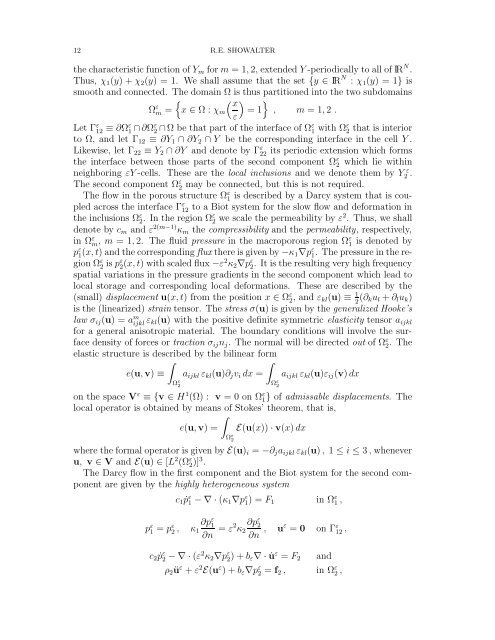Diffusion in Deforming Porous Media - Department of Mathematics
Diffusion in Deforming Porous Media - Department of Mathematics
Diffusion in Deforming Porous Media - Department of Mathematics
Create successful ePaper yourself
Turn your PDF publications into a flip-book with our unique Google optimized e-Paper software.
12 R.E. SHOWALTERthe characteristic function <strong>of</strong> Y m for m = 1, 2, extended Y -periodically to all <strong>of</strong> IR N .Thus, χ 1 (y) + χ 2 (y) = 1. We shall assume that the set {y ∈ IR N : χ 1 (y) = 1} issmooth and connected. The doma<strong>in</strong> Ω is thus partitioned <strong>in</strong>to the two subdoma<strong>in</strong>s{ ( x) }Ω ε m = x ∈ Ω : χ m = 1 , m = 1, 2 .εLet Γ ε 12 ≡ ∂Ωε 1 ∩ ∂Ωε 2 ∩ Ω be that part <strong>of</strong> the <strong>in</strong>terface <strong>of</strong> Ωε 1 with Ωε 2 that is <strong>in</strong>teriorto Ω, and let Γ 12 ≡ ∂Y 1 ∩ ∂Y 2 ∩ Y be the correspond<strong>in</strong>g <strong>in</strong>terface <strong>in</strong> the cell Y .Likewise, let Γ 22 ≡ Y 2 ∩ ∂Y and denote by Γ ε 22 its periodic extension which formsthe <strong>in</strong>terface between those parts <strong>of</strong> the second component Ω ε 2 which lie with<strong>in</strong>neighbor<strong>in</strong>g εY -cells. These are the local <strong>in</strong>clusions and we denote them by Y2 ε.The second component Ω ε 2 may be connected, but this is not required.The flow <strong>in</strong> the porous structure Ω ε 1 is described by a Darcy system that is coupledacross the <strong>in</strong>terface Γ ε 12 to a Biot system for the slow flow and deformation <strong>in</strong>the <strong>in</strong>clusions Ω ε 2 . In the region Ωε 2 we scale the permeability by ε2 . Thus, we shalldenote by c m and ε 2(m−1) κ m the compressibility and the permeability, respectively,<strong>in</strong> Ω ε m , m = 1, 2. The fluid pressure <strong>in</strong> the macroporous region Ωε 1 is denoted byp ε 1 (x, t) and the correspond<strong>in</strong>g flux there is given by −κ 1∇p ε 1 . The pressure <strong>in</strong> the regionΩ ε 2 is pε 2 (x, t) with scaled flux −ε2 κ 2 ∇p ε 2 . It is the result<strong>in</strong>g very high frequencyspatial variations <strong>in</strong> the pressure gradients <strong>in</strong> the second component which lead tolocal storage and correspond<strong>in</strong>g local deformations. These are described by the(small) displacement u(x, t) from the position x ∈ Ω ε 2 , and ε kl(u) ≡ 1(∂ 2 ku l + ∂ l u k )is the (l<strong>in</strong>earized) stra<strong>in</strong> tensor. The stress σ(u) is given by the generalized Hooke’slaw σ ij (u) = a m ijkl ε kl(u) with the positive def<strong>in</strong>ite symmetric elasticity tensor a ijklfor a general anisotropic material. The boundary conditions will <strong>in</strong>volve the surfacedensity <strong>of</strong> forces or traction σ ij n j . The normal will be directed out <strong>of</strong> Ω ε 2 . Theelastic structure is described by the bil<strong>in</strong>ear form∫∫e(u, v) ≡ a ijkl ε kl (u)∂ j v i dx = a ijkl ε kl (u)ε ij (v) dxΩ ε 2on the space V ε ≡ {v ∈ H 1 (Ω) : v = 0 on Ω ε 1} <strong>of</strong> admissable displacements. Thelocal operator is obta<strong>in</strong>ed by means <strong>of</strong> Stokes’ theorem, that is,∫e(u, v) = E(u(x)) · v(x) dxΩ ε 2where the formal operator is given by E(u) i = −∂ j a ijkl ε kl (u) , 1 ≤ i ≤ 3 , wheneveru, v ∈ V and E(u) ∈ [L 2 (Ω ε 2 )]3 .The Darcy flow <strong>in</strong> the first component and the Biot system for the second componentare given by the highly heterogeneous systemc 1 ṗ ε 1 − ∇ · (κ 1 ∇p ε 1) = F 1 <strong>in</strong> Ω ε 1 ,Ω ε 2p ε 1 = pε 2 , κ ∂p ε 11∂n = ∂p εε2 2κ 2∂n , uε = 0 on Γ ε 12 ,c 2 ṗ ε 2 − ∇ · (ε2 κ 2 ∇p ε 2 ) + b ε∇ · ˙u ε = F 2 andρ 2 ü ε + ε 2 E(u ε ) + b ε ∇p ε 2 = f 2 , <strong>in</strong> Ω ε 2 ,
















